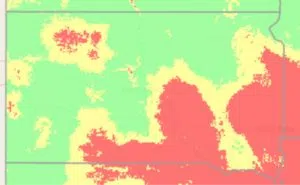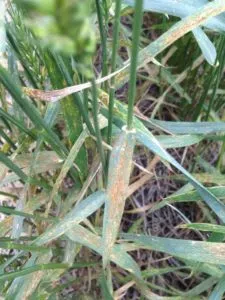BROOKINGS, SD- South Dakota’s spring wheat crop is at risk for Fusarium head blight (FHB) or scab development, said Emmanuel Byamukama, Assistant Professor & SDSU Extension Plant Pathologist.
“Across South Dakota, the majority of spring wheat is at heading and shortly the crop will be flowering. The flowering growth stage coincides with Fusarium head blight (FHB) or scab development. Current weather conditions indicate a moderate to high risk for scab to develop in spring wheat for several counties in the state,” Byamukama said.
Byamukama encouraged wheat producers to protect their crop by applying a triazole fungicide on spring wheat that is approaching flowering. Spring wheat growers in low risk areas of the state, are encouraged to scout spring wheat regularly and watch the weather.”
Weather conditions that favor fungal disease development can change in a short time,” Byamukama said. “The risk for scab development is greatest at flowering and decreases over time after flowering.”
Leaf rust is another disease that is likely to develop in spring wheat because this rust has been found in winter wheat in the state. “
This means there is inoculum in our area, moreover, current weather conditions favor leaf rust to develop,” Byamukama said.
Byamukama explained that leaf rust pathogen does not survive in our area; spores are blown from the southern states. A triazole fungicide applied for scab management will also control foliar fungal diseases including leaf rust.
Fusarium head blight (scab) risk in spring wheat as of 6/26/2018. Red areas indicate high risk, yellow areas indicate moderate risk, while green areas have low disease risk.
Leaf rust pustules on winter wheat leaves. Presence of leaf rust in winter wheat indicates potential for this disease to develop in spring wheat.








